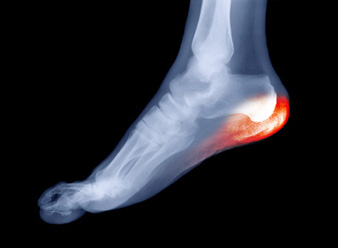TIME WOUNDS ALL HEELS: Heel Pain / Plantar Fascitis
Heel pain commonly refers to any general pain under and around the heel. A sharp pain under the middle of the heel is frequently called Plantar fasciitis. This type of heel pain is often worse when first getting out of bed in the morning or after having been off your feet for a while. It is usually a tearing or stretching pain which can be very painful. If the heel pain is on the back of the heel it can be Achilles pain, relating to the Achilles tendon. If the pain is dull and typically worsens during the day it may just be fatigue from standing on hard surfaces.
Plantar fasciitis is pain in the area of your heel bone where the plantar fascia (the main ligament supporting the arch) connects to the heel bone. The pain is from micro tears caused by over-stretching the plantar fascia. This pain is most commonly due to hyperpronation of the foot (fallen arches and heels leaning in). As the severity of hyperpronation increases, the tension of the plantar fascia increases, causing these micro tears.
If plantar fasciitis is mild, stressing the ligament attachment less will be treatment enough. If the pain is persistent and severe, immobilization will be necessary. In a worst case scenario, using crutches for a few days may be required. Immobilization can be achieved with an arch support which will prevent the foot from hyperpronating during mid-stance and while standing. The gait must also be controlled from mid-stance to toe-off to prevent hyperpronation.
Hyperpronation can cause calluses on both the inside and outside of the heel. Calluses on the inside may be caused by rubbing of the shoe against the side of the heel. Calluses on the outside typically happen as a result of the heel pushing out.
High-Heel Shoes are as bad for the ankles and feet as they are for the rest of the skeletal system:
Ankles: High heels limit the motion and power of the ankle joint. The calf muscles are shortened because of the heel height. The shortened muscles cause them to lose power when trying to push the foot off of the ground. The position of the ankle may also cause a shortening (contraction) of the achilles tendon. This may increase the pull of the achilles tendon where it attaches on the back of your heel bone (calcaneus) and may cause a condition called insertional achilles tendonitis.
Feet: With the foot in a downward position, there is significant increase in the pressure on the bottom of the forefoot. The pressure increases as the height of the shoe heel increases. Wearing a 3 1/4 inch heel increases the pressure on the bottom of the forefoot by 76%. The increased pressure may lead to pain or foot deformities such as hammer toes, bunions, bunionettes (tailor's bunions) and neuromas. The downward foot position (plantarflexion) also causes the foot to be turned to the outside (supinated). This change in foot position changes the line of pull of the achilles tendon and may cause a condition called Haglund's deformity.
Here are a few easy ways to curb or even prevent heel pain:
- Stretch your calves before and after wearing high heels.
- Stretch your plantar fascia by bending your legs so you can reach your feet and gently pull your toes toward your shins. Hold the stretch for 30 seconds and repeat five times on each side. Three stretching sessions per day is often recommended.
- Place a tennis ball on the floor and rest one foot on top of it, sole-down. Roll the ball back and forth along your foot and in circles (in both directions), applying slowly increasing downward pressure. This also stretches your plantar fascia.
- If you do yoga, any pose that incorporates calf stretches or pelvic tilts may be beneficial.
They say, When your foot hurts, you hurt all over. They say it is because it’s true. Better posture will prevent foot injury and pain, and that will contribute to your overall good health and happiness, not to mention a mobile, pain-free life.

